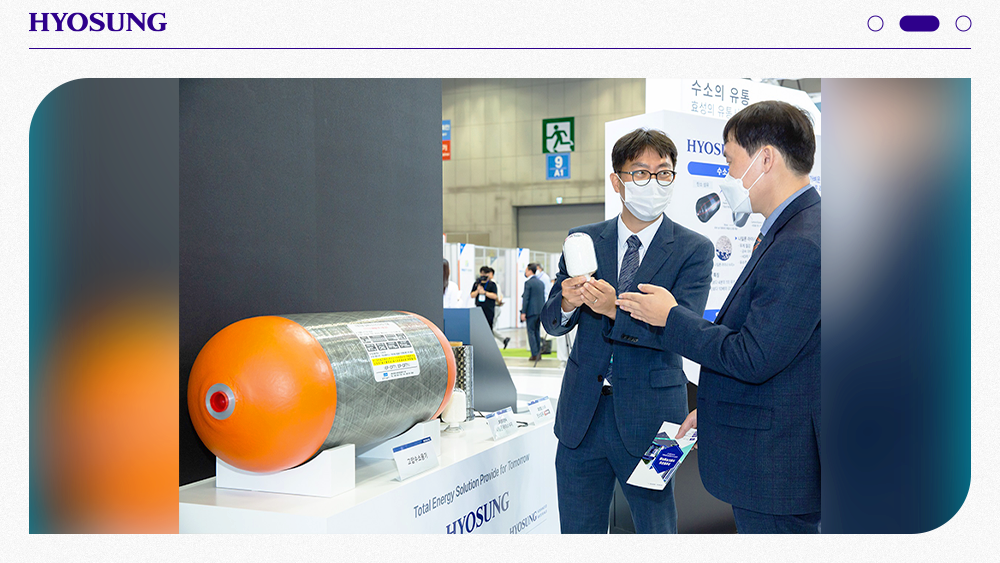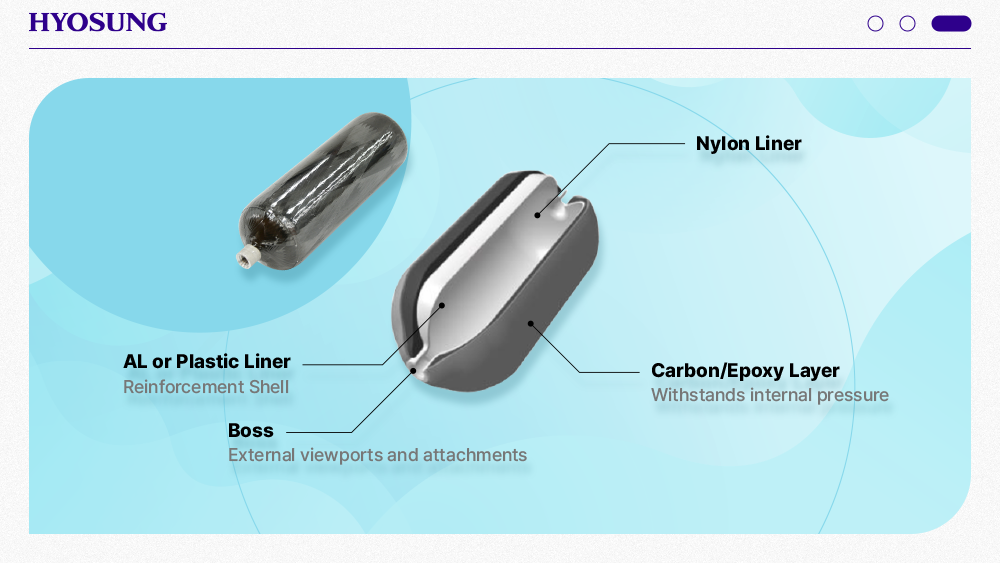Brand Journalism
Brand Journalism
2023-05-04
Hyosung’s Nylon Liner for FCEV
When we think of eco-friendly cars, hydrogen, electric, and hybrid cars come up to one’s mind. Did you know that hydrogen car is a kind of electric car? The official name of hydrogen car is Fuel Cell Electric Vehicle (FCEV). FCEV generates electricity from hydrogen, which runs vehicles. Hydrogen chemically reacts with oxygen at the fuel cell, creating electricity, which is transformed into kinetic energy that runs vehicles. It is different from electric cars as it has a built-in hydrogen tank for storage and fuel cell. The most important part of hydrogen cars is a vessel to safely store highly pressurized hydrogen. What kinds of high-pressure vessels are there?

High-pressure storage vessel – the core part of hydrogen cars
There are four types of high-pressure containers to store gas such as hydrogen.
Type 1) working pressure: 175-200 bar, for LPG (vehicle, household) or CNG
Type 2) working pressure: 250-300 bar, for CNG
Type 3) working pressure: 300-450 bar, for CNG, ventilator
Type 4) working pressure: 700-800 bar, for hydrogen
You can choose a different type of high-pressure vessel based on the features required. Only Type 4 is suitable for storing hydrogen higher than the pressure of 700-bar as it is the most lightweight but most durable which helps to increase the efficiency. Type 1 and Type 2 are relatively cheaper but heavy and vulnerable to corrosion, there is not suitable for cars. Type 3 is lighter than Type 1 and 2, but it cannot withstand the required pressure of hydrogen cars. Type 4 can withstand a much higher pressure but lighter weight than Type 3 thanks to the special liner material. Common liners are steel or aluminum, but Type 4 uses nylon. This is where Hyosung TNC comes in as the manufacturer of the nylon liner.

Hyosung TNC’s Nylon liner, what is special about it?
What is a liner? The high-pressure container that stores hydrogen needs to be resistant to high pressure to store hydrogen safely, block gas to prevent hydrogen leakage, withstand the drastic temperature differences between charging and discharging, and be lightweight to increase the fuel efficiency. It must meet all these requirements, and the liners determine how much pressure the container can withstand. It is inside the fuel tank and an essential component to store hydrogen and prevent leakage. Conventional high-pressure containers such as Type 1 to 3 use metal liners. They are heavy with a high risk of breakage that cracks when exposed to hydrogen for a long time. You can use HDPE (High Density Polyethylene) for Type 4 at 400-bar levels. However, it cannot withstand the 700-bar required by an FCEV. It also has a low level of gas blocking. Meanwhile, Hyosung developed the nylon liner, first of its kind in Korea. It has low hydrogen absorption and air permeability, eliminating potential brittleness, enabling longer and safer use.
Hyosung TNC created the special nylon liner
Hyosung’s nylon liner is 70% lighter than metal and 50% lighter than HDPE. Its gas barrier property is also 30% higher than metal and 50% higher than HDPE. It has everything required by FCEV. It also has an optimized impact resistance from -40ºC to 85ºC.
The nylon liner is enough to be recognized as an outstanding core component, but there is more to Hyosung’s innovation around hydrogen storage technology. Hyosung also has carbon fiber composite on top of the nylon liner, which further enhances the safety of the high-pressure storage tank.

FCEV! Hydrogen Mobility! Hyosung accelerates its efforts for eco-friendliness
The nylon liner market has been dominated by international companies, but Hyosung became the first Korean company to develop the nylon liner, laying the foundation for global market expansion. H2 Research, a renowned market research firm specializing in hydrogen market, predicts that the production of global FCEV market is expected to grow in earnest from 10 thousand and record 1.05 million annual productions by 2030. There is an increasing demand for the nylon liner, where you can use Hyosung’s products. If various hydrogen mobility markets including FCEV expand, it means more potential for nylon liners. With its technology, Hyosung aims to contribute to transitioning into an eco-friendly hydrogen society.
Hyosung has the largest capacity in terms of hydrogen charging stations. It has created a hydrogen value chain through various efforts including construction of liquefied hydrogen plant and filling stations. It also manufactures carbon fiber, an essential element for fuel tanks for FCEV. With nylon liners, it is transforming into a company specializing in hydrogen, with manufacturing capabilities ranging from production to distribution, storage, and utilization. Considering Hyosung’s commitment to environment, it is expected to play a bigger role in the hydrogen industry. The nylon liner is expected to be combined with Hyosung’s regen Nylon, recycled nylon yarn, to become an eco-friendly nylon liner in the future. Hyosung is making its utmost efforts to live up to the industry expectation. Based on advanced technology, Hyosung has been striving to develop sustainable technology for the next generation and the environment. Hyosung’s endeavor to create better solution and technology for better quality of life continues into the future.